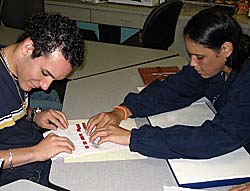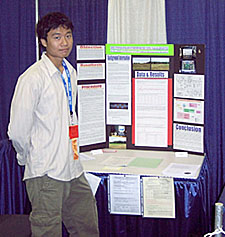Feature
Tuning in the Sounds of Space
04.02.07
| Who are NASA's Space Science Explorers? The scientist studying black holes in distant galaxies. And the engineer designing robotic instruments for probing hard-to-reach planets. But also the teacher explaining the mysteries of the cosmos. And the elementary schooler wondering if life exists anywhere besides Earth. All of these people are Space Science Explorers -- they are all connected by their quest to explore and understand our solar system and universe. This monthly series will introduce you to NASA Space Science Explorers, young and old, with a variety of backgrounds and interests. Nominate a Space Science Explorer! Tell us about the Space Science Explorers you know. We're looking for students, teachers, scientists and others who have a connection to NASA, whether they work for the agency or are involved in a NASA-supported mission or program. Send your nominations to Dan Stillman: dan_stillman@strategies.org. |
Ocean waves breaking up on a beach. Pebbles landing on a tin roof. A quiet hiss.
Sandy beaches, tin roofs and hissing snakes don't exist in space. But with the right equipment, these are the kinds of noises derived from radio signals emitted by extraterrestrial bodies and the Milky Way galaxy in general.

|
Image to right: Wanda Diaz teaches an astronomy class for blind students at the University of Puerto Rico. Credit: Wanda Diaz
Diaz has not let her visual impairment interfere with her passion for radio astronomy, or prevent her from passing that passion on to a new generation of astronomers. NASA's Radio JOVE project has played an important role in her ability to conduct research and to teach astronomy to younger students.
The Radio JOVE kit contains all the parts needed to build a radio telescope. The main components are the antenna and receiver. The antenna picks up the powerful bursts of radio signals that the sun and Jupiter create. The receiver converts the signals into audio, letting observers listen to celestial objects that are millions of miles away. Diaz says that by listening to radio data, she finds herself grasping details that she otherwise may not have noticed.
Carrying out research without sight is difficult at first and it is easy to get discouraged, she said, but you soon discover the importance of your other senses, like touch and hearing, and "then you realize that you're finding hidden patterns."
Diaz first became interested in radio astronomy six years ago while earning her undergraduate degree in physics. She had started to lose her sight because of diabetes, and worried about how that would affect her career. But things fell into place when she learned of Radio JOVE, and that she could listen to radio signals and analyze them. "I was asking myself, 'How could I be a physicist and how could I do astronomy when I'm losing my sight?'" Diaz said. "Then, I heard about Radio JOVE and I said, 'OK, this is the way to go.'"

|
Image to left: Goddard scientist Leonard Garcia helps George Mason University student Young Lee solder the parts of a radio receiver circuit. Credit: Wanda Diaz
Data collected can be used for various research projects, from gauging the strength and predictability of radio storms to learning about changes in the ionosphere -- the electrically charged outer layer of the Earth's atmosphere. Students can even share their observations with amateur and professional radio astronomers.
At the Higinio Figueroa Villegas school in Maunabo, Puerto Rico, Diaz is helping seventh-graders to detect meteors using special software compatible with Radio JOVE. Passing through Earth's upper atmosphere, meteors leave behind a trail of charged air particles, which reflect radio signals transmitted from Earth. At four other schools, she has helped students build Radio JOVE telescopes. The students are now searching for radio emissions from the sun and Jupiter.
Diaz began visiting schools more than a year ago to reach out to students, and during this time she has seen their interest in radio astronomy increase. She gets a lot out of it, too. "They listen to the data, and have lots of fun doing it. They get to learn and I get to corroborate if I ... really heard something significant."
To make astronomy easier for people with visual impairments, Diaz helps test software invented by Goddard researchers that maps numerical data to sounds such as the human voice or musical instruments. Users can manipulate and analyze the data by changing variables, such as the pitch or the volume.
|
Related Resources + Previous Space Science Explorers articles + Radio JOVE + Deep Space Network -- Radio Astronomy + Goldstone Apple Valley Radio Telescope + NASA Education Web Site |
In Radio JOVE, building the radio telescope is just as important as analyzing the data it observes. With the help of elementary school students, Diaz and Goddard scientist Leonard Garcia have developed a new technique to solder, or join, the parts of the radio receiver circuit. The method is safe for children and is an invaluable tool for blind people who want to construct their own radio telescope.
For students, Diaz says that learning radio astronomy through hands-on activities, such as setting up a radio antenna and constructing a receiver circuit, is fun. She encourages students to set their own goals and not to give up on their dreams, no matter the challenges they may face.
"I tell them that the only obstacle between them and their dreams is themselves," Diaz said. "Nothing is impossible."
Through this project, NASA continues its tradition of investing in the nation's education and furthers its major education goal of attracting and retaining students in science, technology, engineering and mathematics disciplines. To compete effectively for the minds, imaginations and career ambitions of America's young people, NASA is focused on engaging and retaining students in education efforts that encourage their pursuit of disciplines critical to NASA's future engineering, scientific and technical missions.
Image to right: Hieu Tran, a senior at Southside High School in Greenville, S.C., built a radio interferometer. His project earned him the Richard D. Lines Special Award in Astronomy at the 2006 Intel Science and Engineering Fair. Credit: Hieu Tran Tran made a radio interferometer, a device that combines two radio signals. Interferometers sense radio signals more easily than a single receiver, so they can tune into signals from sources much smaller than the sun and Jupiter. The interferometer also efficiently eliminates background noise, including signals from electric equipment and machinery in the surrounding area. The elimination of extraneous noise makes it easier to confirm that the sounds the receiver is detecting are from space. Tran worked with David Moffett, a physics professor at Furman University. Moffett said that the project was a learning experience for him as well, because it was the first time he had been involved in building an interferometer. "I knew how it worked in theory, but I'd never actually built one in practice," he said. For Tran, stepping outside the bounds of the classroom and working with a university researcher was an eye-opening experience. "After I was introduced to [Radio JOVE] and I found out how fun it was to set up my own goals and achieve them -- to go out and research something that wasn’t part of school -- it gave me a lot of satisfaction," he said. It showed "what I'm able to do if I just put my mind to it." |
